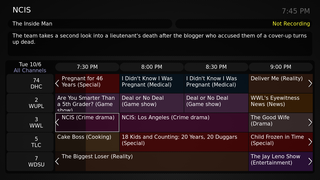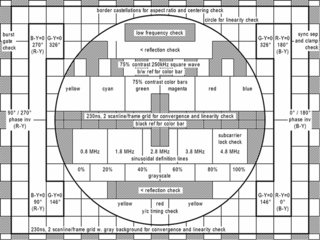Related Research Articles

NTSC is the first American standard for analog television, published and adopted in 1941. In 1961, it was assigned the designation System M. It is also known as EIA standard 170.

A television channel, or TV channel, is a terrestrial frequency or virtual number over which a television station or television network is distributed. For example, in North America, channel 2 refers to the terrestrial or cable band of 54 to 60 MHz, with carrier frequencies of 55.25 MHz for NTSC analog video (VSB) and 59.75 MHz for analog audio (FM), or 55.31 MHz for digital ATSC (8VSB). Channels may be shared by many different television stations or cable-distributed channels depending on the location and service provider
A subcarrier is a sideband of a radio frequency carrier wave, which is modulated to send additional information. Examples include the provision of colour in a black and white television system or the provision of stereo in a monophonic radio broadcast. There is no physical difference between a carrier and a subcarrier; the "sub" implies that it has been derived from a carrier, which has been amplitude modulated by a steady signal and has a constant frequency relation to it.
Second audio program (SAP), also known as secondary audio programming, is an auxiliary audio channel for analog television that can be broadcast or transmitted both over-the-air and by cable television. Used mostly for audio description or other languages, SAP is part of the multichannel television sound (MTS) standard originally set by the National Television Systems Committee (NTSC) in 1984 in the United States. The NTSC video format and MTS are also used in Canada and Mexico.

Amateur television (ATV) is the transmission of broadcast quality video and audio over the wide range of frequencies of radio waves allocated for radio amateur (Ham) use. ATV is used for non-commercial experimentation, pleasure, and public service events. Ham TV stations were on the air in many cities before commercial television stations came on the air. Various transmission standards are used, these include the broadcast transmission standards of NTSC in North America and Japan, and PAL or SECAM elsewhere, utilizing the full refresh rates of those standards. ATV includes the study of building of such transmitters and receivers, and the study of radio propagation of signals travelling between transmitting and receiving stations.
Superstation is a term in North American broadcasting that has several meanings. Commonly, a "superstation" is a form of distant signal, a broadcast television signal—usually a commercially licensed station—that is retransmitted via communications satellite or microwave relay to multichannel television providers over a broad area beyond its primary terrestrial signal range.
Datacasting is the transmission of data over a wide area using radio waves. It typically refers to supplemental information sent by television stations alongside digital terrestrial television (DTT) signals. However, datacasting can also be applied to digital data signals carried on analog TV or radio broadcasts.
NewsNation is an American cable news network owned by Nexstar Media Group.

VideoCipher is a brand name of analog scrambling and de-scrambling equipment for cable and satellite television invented primarily to enforce Television receive-only (TVRO) satellite equipment to only receive TV programming on a subscription basis.
Television encryption, often referred to as scrambling, is encryption used to control access to pay television services, usually cable, satellite, or Internet Protocol television (IPTV) services.
Satellite Syndicated Systems, Inc. (SSS) was a company founded in 1978 as a division of Southern Satellite Systems, Inc., dedicated to the exploration and development of new satellite communication opportunities, especially for the then-new industry of satellite television distribution.

The Open Student Television Network (OSTN), is a USA national student television network, headquartered in downtown Cleveland, Ohio. OSTN was founded in the fall of 2004 and launched its high-bitrate IPTV stream on February 28, 2005.

WPCH-TV, branded on-air as Peachtree TV, is a television station in Atlanta, Georgia, United States, affiliated with The CW. It is owned by locally based Gray Television alongside CBS affiliate and company flagship WANF, and low-power, Class A Telemundo affiliate WKTB-CD. WPCH-TV and WANF share studios on 14th Street Northwest in Atlanta's Home Park neighborhood; WPCH-TV's transmitter is located in the Woodland Hills section of northeastern Atlanta.

Satellite News Channel (SNC) was an American short-lived news-based cable television channel that was operated as a joint venture between the ABC Video Enterprises division of American Broadcasting Companies, Inc. (a.k.a. ABC) and the Group W Satellite Communications subsidiary of Westinghouse Broadcasting Company (a.k.a. Group W). Designed as a satellite-delivered cable network, the channel is best remembered as the first 24-hour news cable competition to the Cable News Network (CNN). SNC's headquarters were based in the New York City suburb of Stamford, Connecticut.
Cable television first became available in the United States in 1948. By 1989, 53 million U.S. households received cable television subscriptions, with 60 percent of all U.S. households doing so in 1992. Most cable viewers in the U.S. reside in the suburbs and tend to be middle class; cable television is less common in low income, urban, and rural areas.

Satellite television is a service that delivers television programming to viewers by relaying it from a communications satellite orbiting the Earth directly to the viewer's location. The signals are received via an outdoor parabolic antenna commonly referred to as a satellite dish and a low-noise block downconverter.
In broadcasting, local insertion is the act or capability of a broadcast television station, radio station or cable system to insert or replace part of a network feed with content unique to the local station or system. Most often this is a station identification, but is also commonly used for television or radio advertisements, or a weather or traffic report. A digital on-screen graphic, commonly a translucent watermark, may also be keyed (superimposed) with a television station ID over the network feed using a character generator using genlock. In cases where individual broadcast stations carry programs separate from those shown on the main network, this is known as regional variation or an opt-out.

A free-to-air or FTA Receiver is a satellite television receiver designed to receive unencrypted broadcasts. Modern decoders are typically compliant with the MPEG-4/DVB-S2 standard and formerly the MPEG-2/DVB-S standard, while older FTA receivers relied on analog satellite transmissions which have declined rapidly in recent years.
Satellite subcarrier audio is audio transmitted by way of satellite that uses a separate analog or digital signal carried on a main radio transmission on a specific satellite transponder. More technically, it is an already-modulated signal, which is then modulated into another signal of higher frequency and bandwidth. In a more general sense, satellite subcarrier audio is an early form of satellite radio not intended for the consumer market but was initially unencrypted, thus receivable to satellite hobbyists.

WGN America was an American subscription television network that operated from November 9, 1978 to February 28, 2021. The service was originally uplinked to satellite by United Video Inc. as a national feed of Chicago independent station WGN-TV, making the station's programming available to cable and satellite providers throughout the United States as the second nationally distributed "superstation".
References
- ↑ Southworth, Glen. "Narrowband Video: The UPI "Newstime" Technology". National Cable & Telecommunications Association. Retrieved November 29, 2015.
- ↑ Southworth, Glen. "Narrowband Video: The UPI "Newstime" Technology". National Cable & Telecommunications Association. Retrieved November 29, 2015.
- ↑ "A decision to shut down UPI NEWSTIME service to..." United Press International. Retrieved November 29, 2015.
- ↑ "United Press International Wednesday announced an agreement in principle..." United Press International. Retrieved November 29, 2015.
- ↑ "Freeze-frame television can be a cost-effective choice for images that don't require motion to be understood". Communications News. Retrieved June 18, 2016.